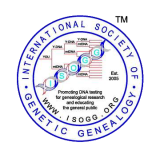Visual Phasing Pseudo-Sibling Phasing Round (Borland Genetics)
From ISOGG Wiki
During this stage of a Borland Genetics Visual Phasing Smart Project, any project sibling donors without tested children are phased against each other across their HIR (Half-Identical) regions. Due to technical constraints, only the out-of-phase streams of genetic data are useful for the reconstruction process. The phased output kits, termed Pseudo-Sibling kits, resemble siblings in that they encompass significant portions of both paternal and maternal genetic data. Each phased HIR region contributes a block of either paternal or maternal data useful for parent reconstruction. In the subsequent Pseudo-Sibling Mapping Round the user will be tasked with discerning whether each such block is paternal or maternal. Siblings with tested children will circumvent this stage. Instead, Reverse Phase projects specific to each such sibling will be established. Here, a more comprehensive reconstruction of the parents is generated. The output from any Reverse Phase Smart Projects spawned by the Creeper in the user’s Visual Phasing Smart Project will be automatically routed back to the ongoing project, ready for use during the Phased Parent Kit Mapping Round. Should any two or more of the project's sibling donors lack children, Pseudo-Sibling kits will be produced at this juncture. As the next phase involves mapping these phased Pseudo-Sibling kits based on their matches within the system, the project must temporarily halt. This pause allows for the Pseudo-Sibling kits to complete batch processing, where they are matched against existing kits in the database. This matching process can take anywhere from 30 minutes to 24 hours.
